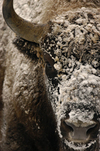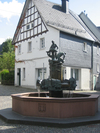The Hauberg

The Hauberg is a typical form of cooperative forestry for the Siegerland and the neighbouring parts like Altenkirchen, Westerwald and Lahn-Dill-district. It was used for the winning tanbark, charcoal for the regional significant iron ore processing and of firewood. In addition to the forestry, an agricultural usage took place.
The Hauberg is an oak-birch coppice, where also sporadic other tree species exist. When these trees are 16 – 20 years old, they will be thinned out, decided by the Hauberg executive board.
Start of a Hauberg season is in autumn, in the first week in October. Every plot is being divided into equal parts. A lottery decides which part goes to which person or groups of people.

About the history: 2.500 years ago, a new era started in Europe, iron was discovered as raw material. On their migration to the north, the Celts also came to the Siegerland. There, metalliferous veins reach up to the surface (called sinkholes). In piles, wood was turned into charcoal to reach high temperatures in small hillside kilns, without one couldn't win iron.
The beech groves in the region didn't survive that. Due to the high wood demand, the beech trees were felled in ever shorter intervals, before regrowth could take place. Oak and birches perform better. Thus the beech high forest of the region became an oak-birch coppice.
But after 600 years, this forest was also gone, the Siegerland was bare. No forest also meant no charcoal. Where there is no power, there one can't smelt, thus the Celts moved on.
The forest needed 800 years to recover. As a form of sustained cultivation, the Siegerland Hauberg developed. It was a coppice (mostly oak/birch) owned by cooperatives.
At the end of the 19th-century, the railway Siegen – Cologne was built. Thus, coal could be inexpensively transported from the Siegerland to the Ruhr area. The demand for charcoal diminished.
Today, the Hauberg is being used privately, mostly for firewood.

 Deutsch
Deutsch Nederlands
Nederlands Dansk
Dansk Österreichisch
Österreichisch Po Polsku
Po Polsku









